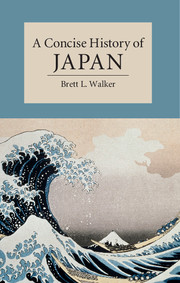Book contents
- Frontmatter
- Dedication
- Contents
- List of Illustrations
- List of Maps
- Preface
- Chronology
- Introduction
- 1 The Birth of the Yamato State, 14,500 bce – 710 ce
- 2 The Courtly Age, 710–1185
- 3 The Rise of Samurai Rule, 1185–1336
- 4 Medieval Japan and the Warring States Period, 1336–1573
- 5 Japan’s Encounter with Europe, 1543–1640
- 6 Unifying the Realm, 1560–1603
- 7 Early Modern Japan, 1600–1800
- 8 The Rise of Imperial Nationalism, 1770–1854
- 9 Meiji Enlightenment, 1868–1912
- 10 Meiji’s Discontents, 1868–1920
- 11 The Birth of Japan’s Imperial State, 1800–1910
- 12 Empire and Imperial Democracy, 1905–1931
- 13 The Pacific War, 1931–1945
- 14 Japan’s Post-War History, 1945–Present
- 15 Natural Disasters and the Edge of History
- Glossary
- Further Reading
- Index
15 - Natural Disasters and the Edge of History
Published online by Cambridge University Press: 05 March 2015
- Frontmatter
- Dedication
- Contents
- List of Illustrations
- List of Maps
- Preface
- Chronology
- Introduction
- 1 The Birth of the Yamato State, 14,500 bce – 710 ce
- 2 The Courtly Age, 710–1185
- 3 The Rise of Samurai Rule, 1185–1336
- 4 Medieval Japan and the Warring States Period, 1336–1573
- 5 Japan’s Encounter with Europe, 1543–1640
- 6 Unifying the Realm, 1560–1603
- 7 Early Modern Japan, 1600–1800
- 8 The Rise of Imperial Nationalism, 1770–1854
- 9 Meiji Enlightenment, 1868–1912
- 10 Meiji’s Discontents, 1868–1920
- 11 The Birth of Japan’s Imperial State, 1800–1910
- 12 Empire and Imperial Democracy, 1905–1931
- 13 The Pacific War, 1931–1945
- 14 Japan’s Post-War History, 1945–Present
- 15 Natural Disasters and the Edge of History
- Glossary
- Further Reading
- Index
Summary
In the nineteenth century, when Meiji reformers set in motion Japan’s rapid industrialization, they recognized only its obvious economic and military benefits, ones ruthlessly demonstrated by Western imperialism. Since then, Japan has become part of a community of wealthy nations who have, through the burning of fossil fuels, slowly undermined the relatively stable climate that has insulated human civilizations. Since the Meiji transition to non-renewable energy, Japan has become a major global contributor to climate change, with carbon dioxide equivalents, or greenhouse gases, at 1,390 megatons in 2005, more than Germany or the UK. One consequence of Earth’s changing climate is sea level rise, which poses serious challenges to many island nations in the Pacific, including Japan. The link between Japan’s nineteenth-century industrialization and the reality of rising oceans is unequivocal and has placed Japan on a precarious historical precipice. For all the benefits of nineteenth-century ‘civilization and enlightenment’, and the economic growth they offered, within a handful of generations it has come to threaten Japan at a fundamental level. Japan’s climate, topography, and biodiversity are in the thrall of dramatic changes, and therefore so is the nation that this physical environment supports. As one historian has observed, the ‘discipline of history exists on the assumption that our past, present, and future are connected by a certain continuity of human experience’, but climate change threatens those continuities. In the case of Japan, climate change has underwritten a tumultuous half-century, in which natural forces, from seismic events to Pacific super storms, interface with unnatural ones, such as coastal settlement patterns and land reclamation, to set the tone for Japan’s twenty-first century prospects.
- Type
- Chapter
- Information
- A Concise History of Japan , pp. 283 - 304Publisher: Cambridge University PressPrint publication year: 2015

